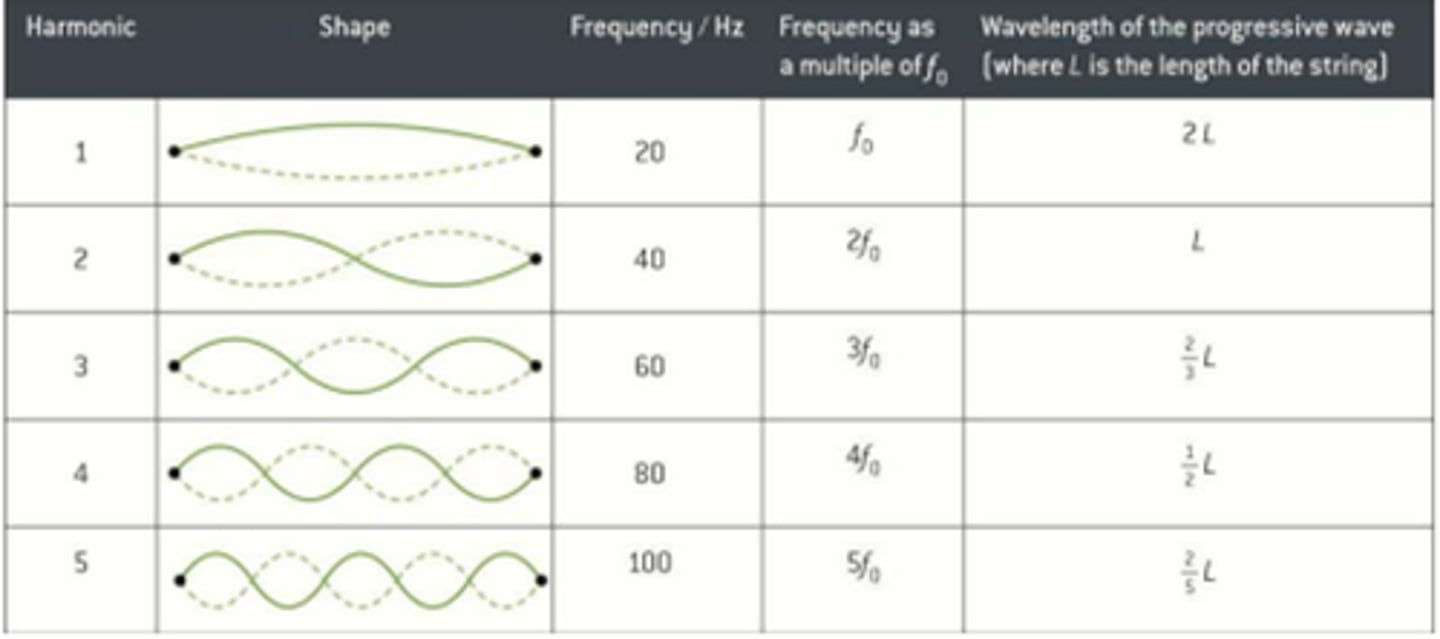StemUp: OCR A A level Physics 4.4: Waves
1/72
There's no tags or description
Looks like no tags are added yet.
Name | Mastery | Learn | Test | Matching | Spaced |
|---|
No study sessions yet.
73 Terms
What is a progressive wave? (1)
This is an oscillation that travels through a medium (or a vacuum) transferring energy from one place to another but not transferring any matter.
What is a longitudinal wave? (3)
- This is a type of progressive wave.
- The oscillations are parallel to the direction of energy transfer.
- There are compressions where particles are close together and rarefactions where they are spread apart.
What are some examples of longitudinal waves? (2)
- Sound waves
- Waves on a spring when being shook side to side
What is a transverse wave? (3)
- This is a type of progressive wave.
- The oscillations are perpendicular to the direction of energy transfer.
- There are peaks at maximum displacement and troughs at minimum displacement.
What are some examples of transverse waves? (3)
- Electromagnetic waves
- Water waves
- Spring waves when being shook up and down
What is meant by displacement of a wave? (1)
This is the distance from the equilibrium position. It is measured in meters (m).
What is meant by the amplitude of a wave? (1)
This is the maximum displacement of the wave from the equilibrium position. It is measured in meters (m).
What is meant by the wavelength of a wave? (1)
This is the distance between two adjacent points on a wave which have the same phase. It is measured in meters (m).
How is the wavelength of a longitudinal wave found? (1)
This is the distance between two adjacent compressions or rarefactions.
How is the wavelength of a transverse wave found? (1)
This is the distance between two adjacent peaks or troughs.
What is meant by the period of a wave? (1)
This is the time taken for a full oscillation of a wave to pass a given point.
What is meant by the phase difference of a wave? (1)
This is the difference in displacement of particles along a wave or in two different waves, measured in radians.
What is meant by being in phase? (1)
This is when the phase difference is a multiple of 2𝜋 and the particles (or waves) oscillate in sync. Anything other than this phase difference means the particles or waves are out of phase.
What is meant by being in antiphase? (1)
If the phase difference is a multiple of 𝜋 the particles (or waves) are in antiphase. They are half a wavelength out of sync.
How is the phase difference calculated? (1)
If the particles are out of phase and have a separation of x meters.
The equation 𝑥 \𝜆 x 2𝜋 can be used to find the phase difference where 𝜆 is the wavelength of the wave.
What is meant by the frequency? (1)
This is the number of complete oscillations passing through a point per second.
What is the equation for frequency? (1)
Frequency (f) is given by f = 1 / T where T is the period of the wave in seconds.
What is the unit and S.I. unit for frequency? (2)
The unit for frequency is the Hertz (Hz) and the S.I. base unit is s⁻¹
What is meant by the wave speed? (1)
This is the distance a wave travels per second, measured in meters per second (ms⁻¹)
What is the wave speed formula? (1)
For a wave with a wavelength (𝜆) and a frequency (f) the wave speed is given by the formula v = f𝜆
How can a transverse wave be represented graphically? (2)
This shows how a particle will be displaced as a transverse wave moves across the medium.
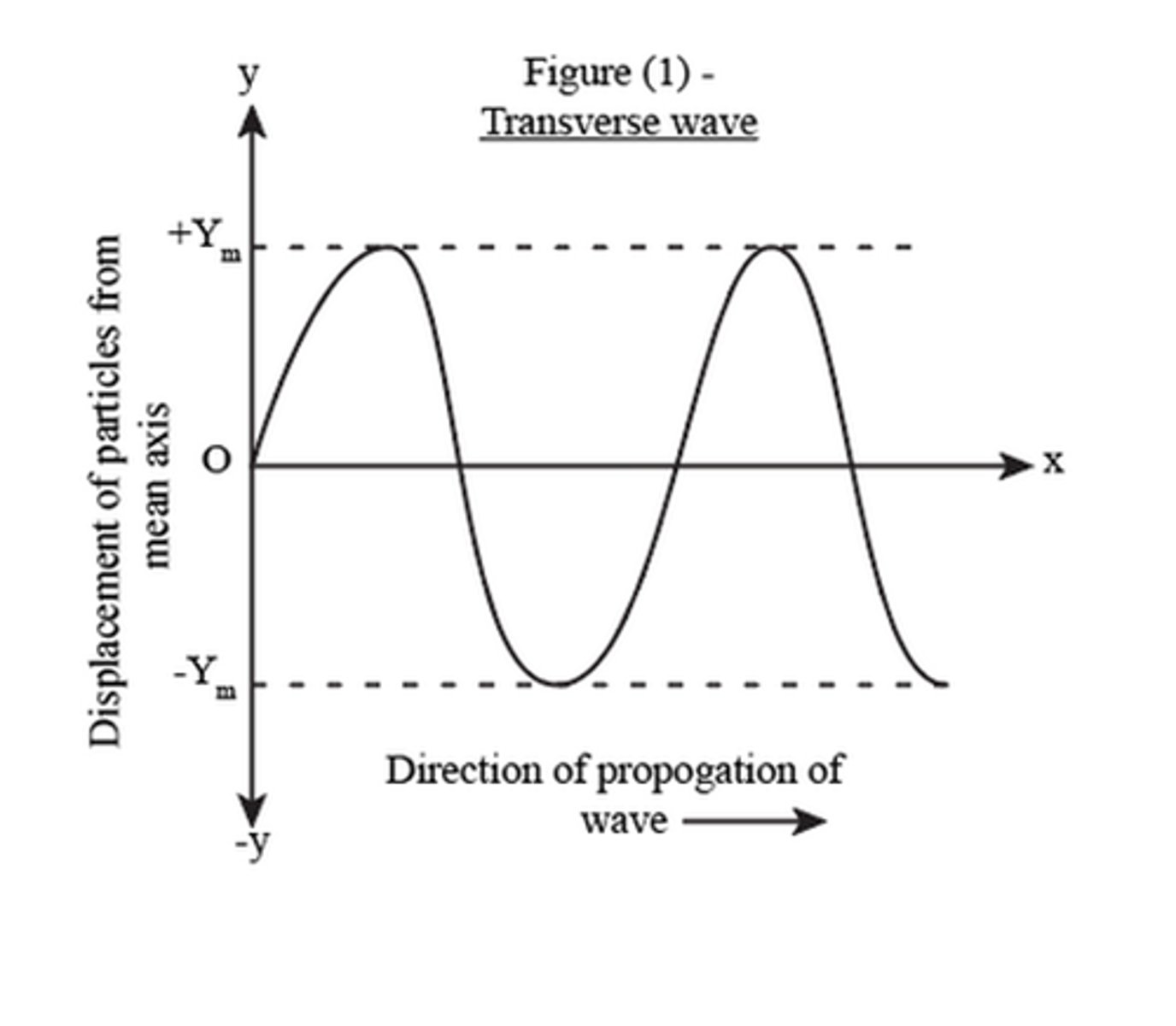
How can a longitudinal wave be represented graphically? (1)
This shows how the density of the medium will change (with compressions at the peaks and rarefactions at the troughs) as a longitudinal wave moves through the medium.
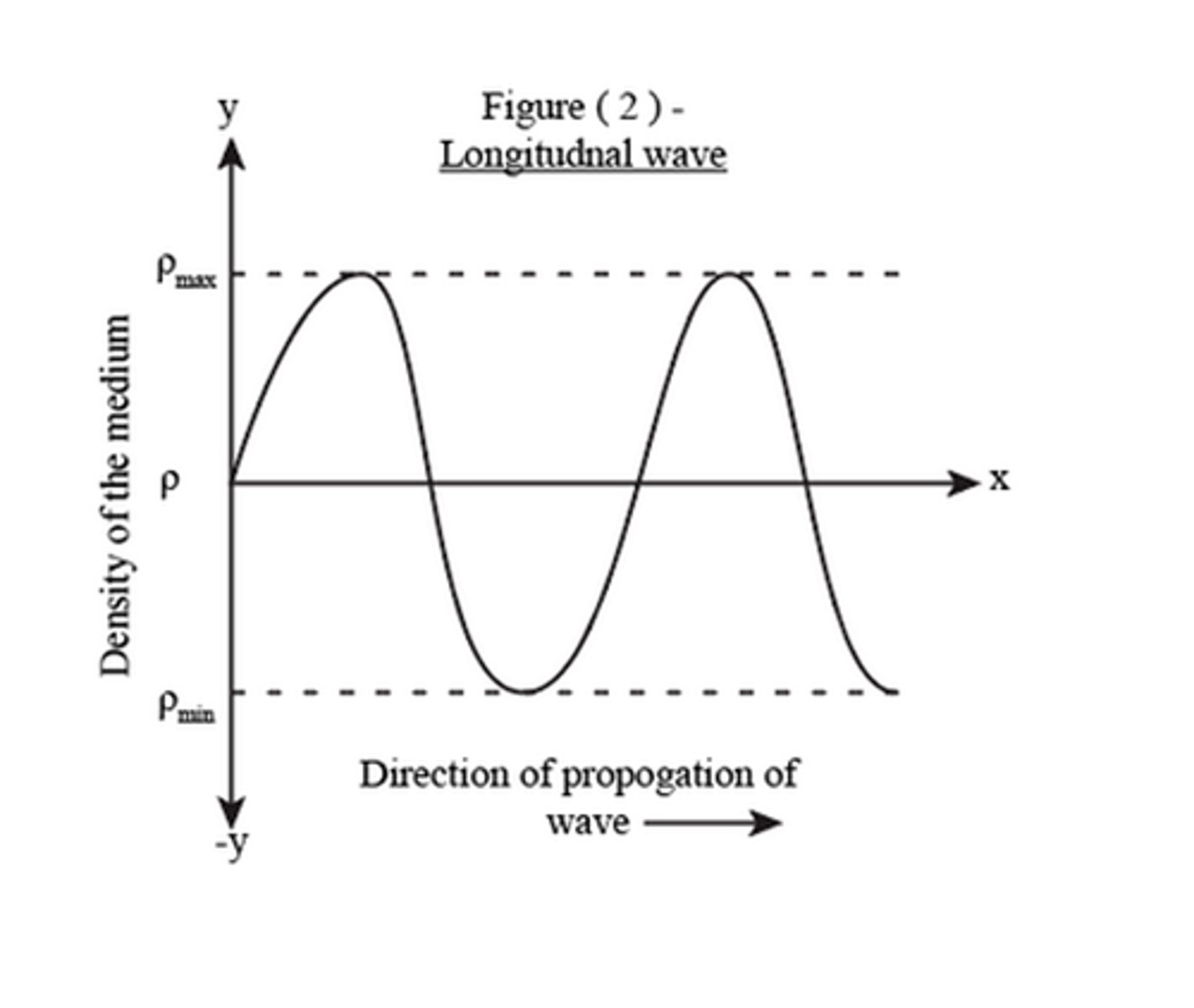
What is meant by reflection of a wave and what does it look like? (2)
- Reflection occurs when a wave changes direction at a boundary between two mediums but remains in the original medium.
- The angle of incidence is equal to the angle of reflection.
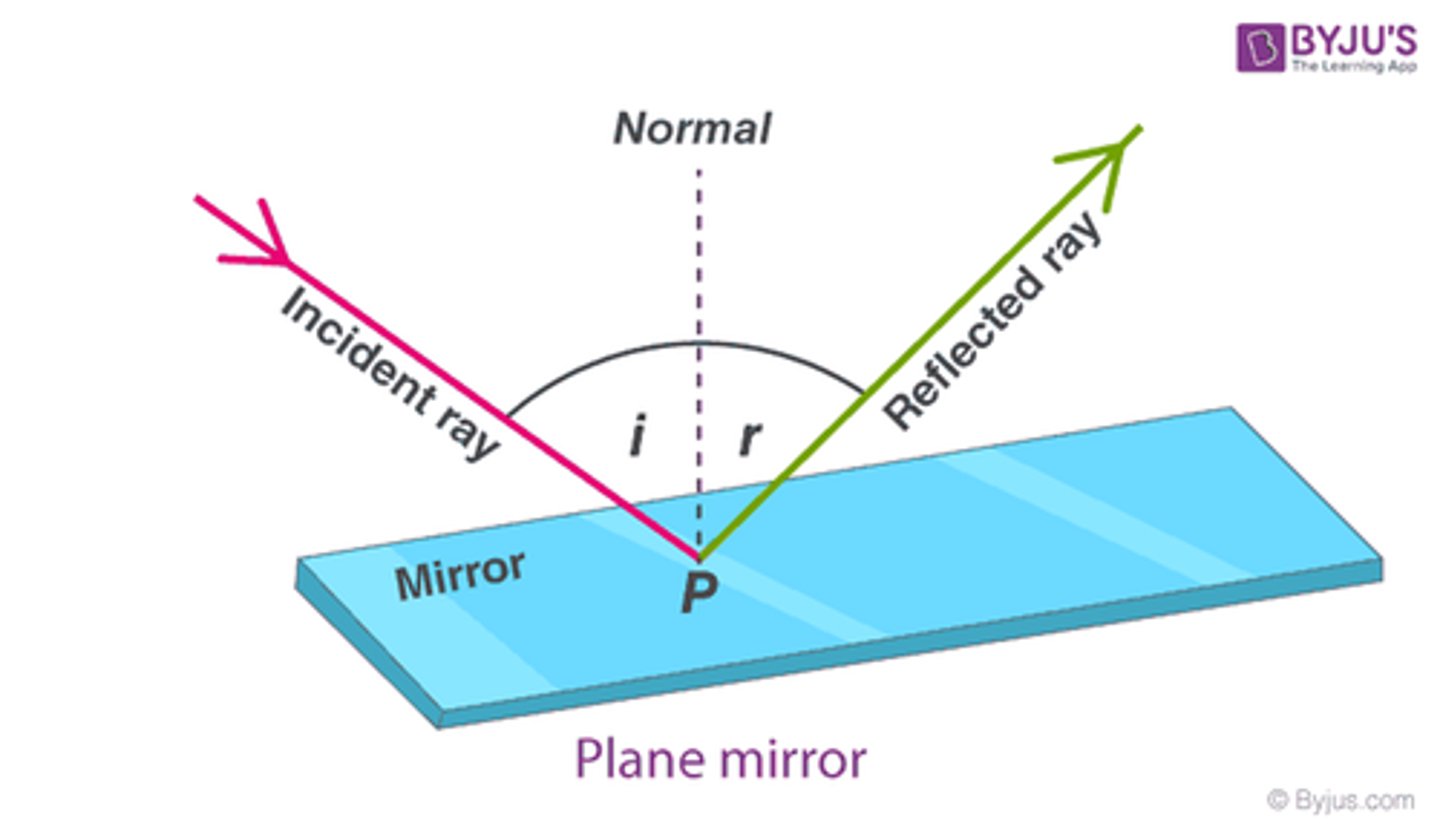
What is meant by refraction of a wave and what does it look like? (4)
- This is when a wave changes direction and speed when entering a new medium.
- The frequency remains constant but the wavelength changes as the speed changes due to the equation v = f𝜆
- Sound waves speed up in denser materials whilst electromagnetic waves slow down.
- The angle of incidence and angle of refraction may be different.
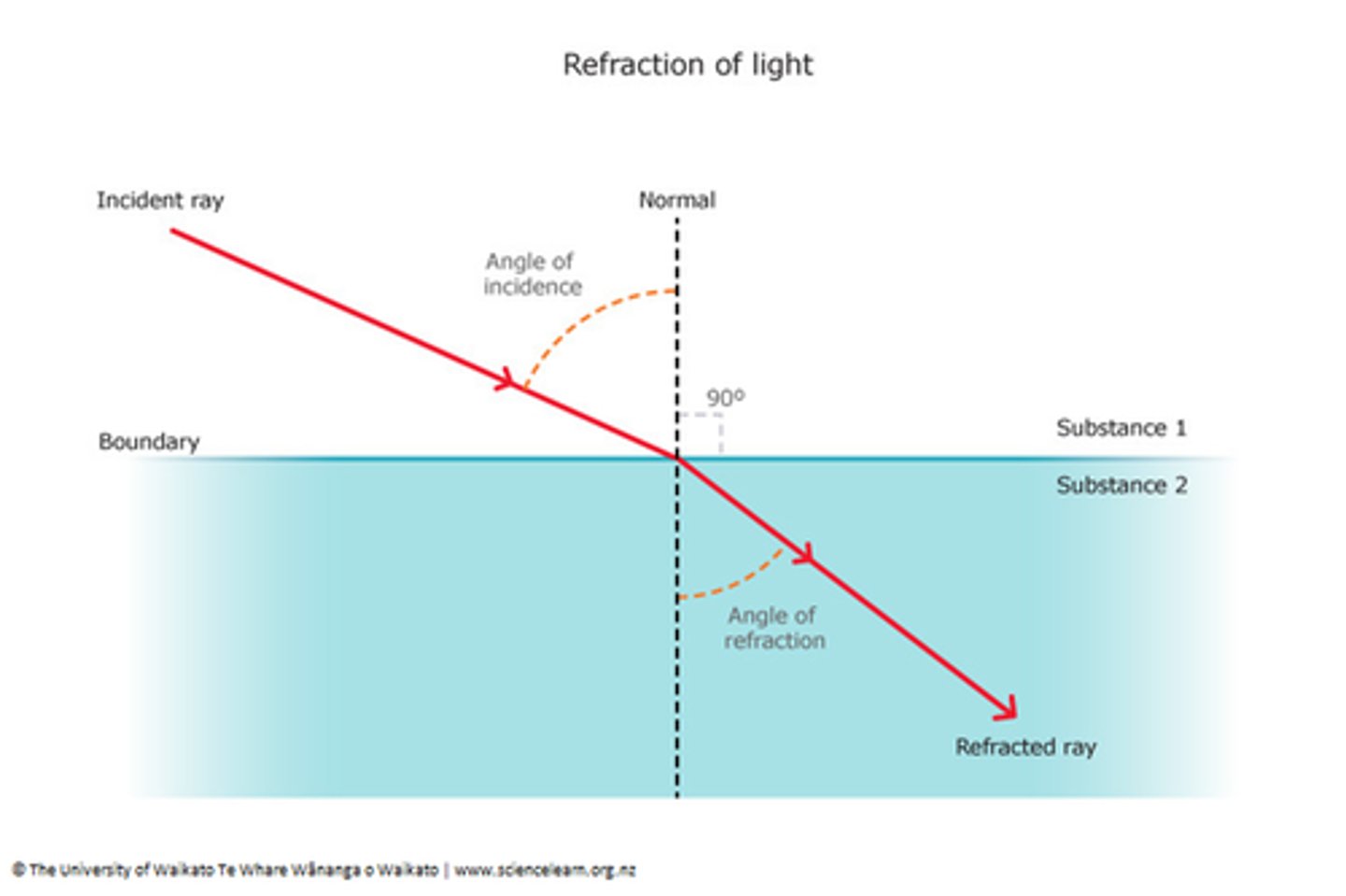
What happens to the speed of a wave in refraction? (2)
- The speed of the wave will change as wavelength changes and speed and wavelength are linked by the formula v = f𝜆
- Sound waves will speed up in denser mediums whilst electromagnetic waves will slow down in denser mediums.
What is meant by diffraction of a wave and what does it look like? (2)
- This is the spreading out of wave energy as a wave passes through a gap or goes around an obstacle.
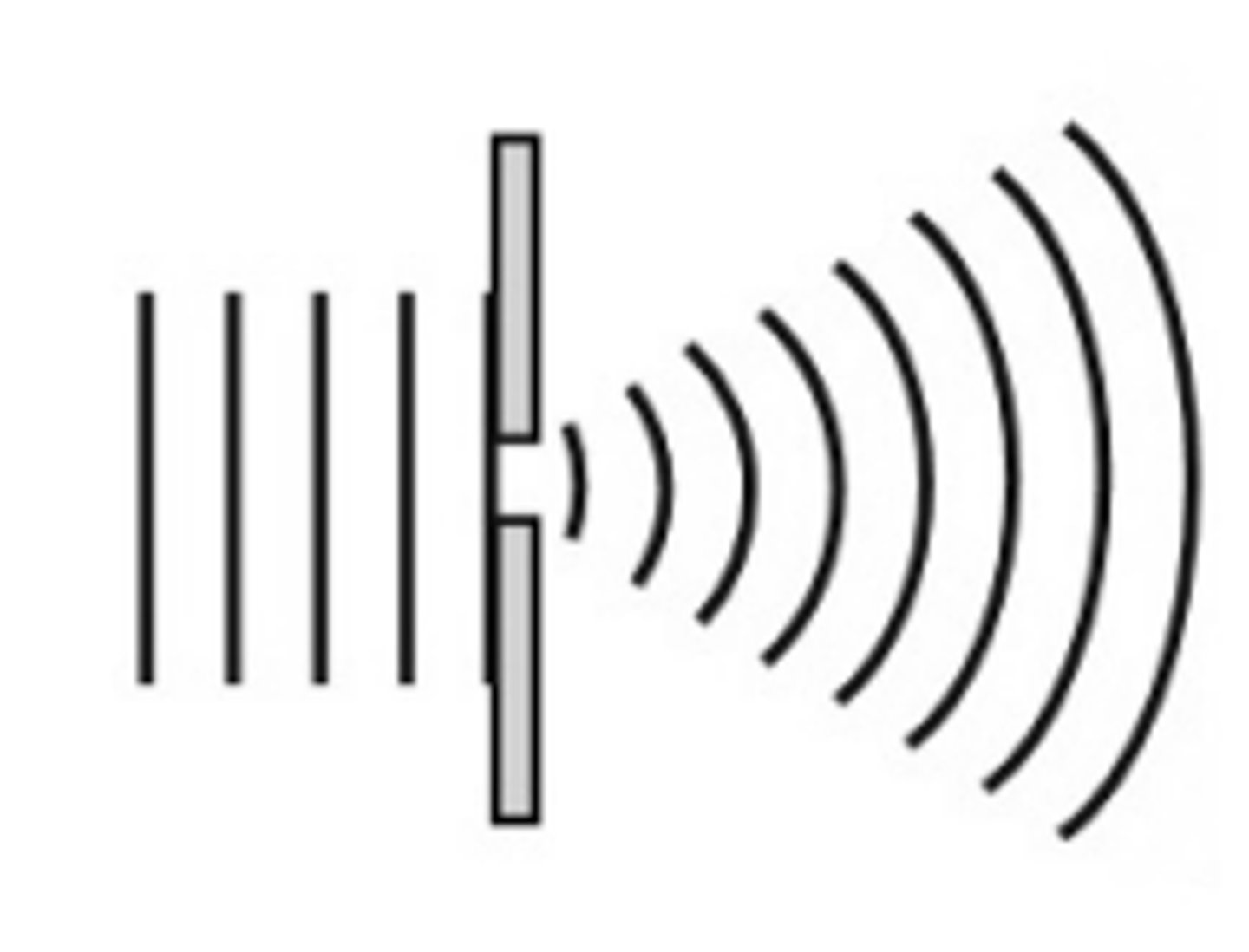
How does the size of the gap affect diffraction? (1)
The effects of diffraction are at its maximum when the size of the gap is equal to the wavelength of the incident wave.
What is meant by polarisation of a wave and what does it look like? (2)
- Polarisation is unique to transverse waves.
- It is when the oscillation of the wave is restricted to one plane only.
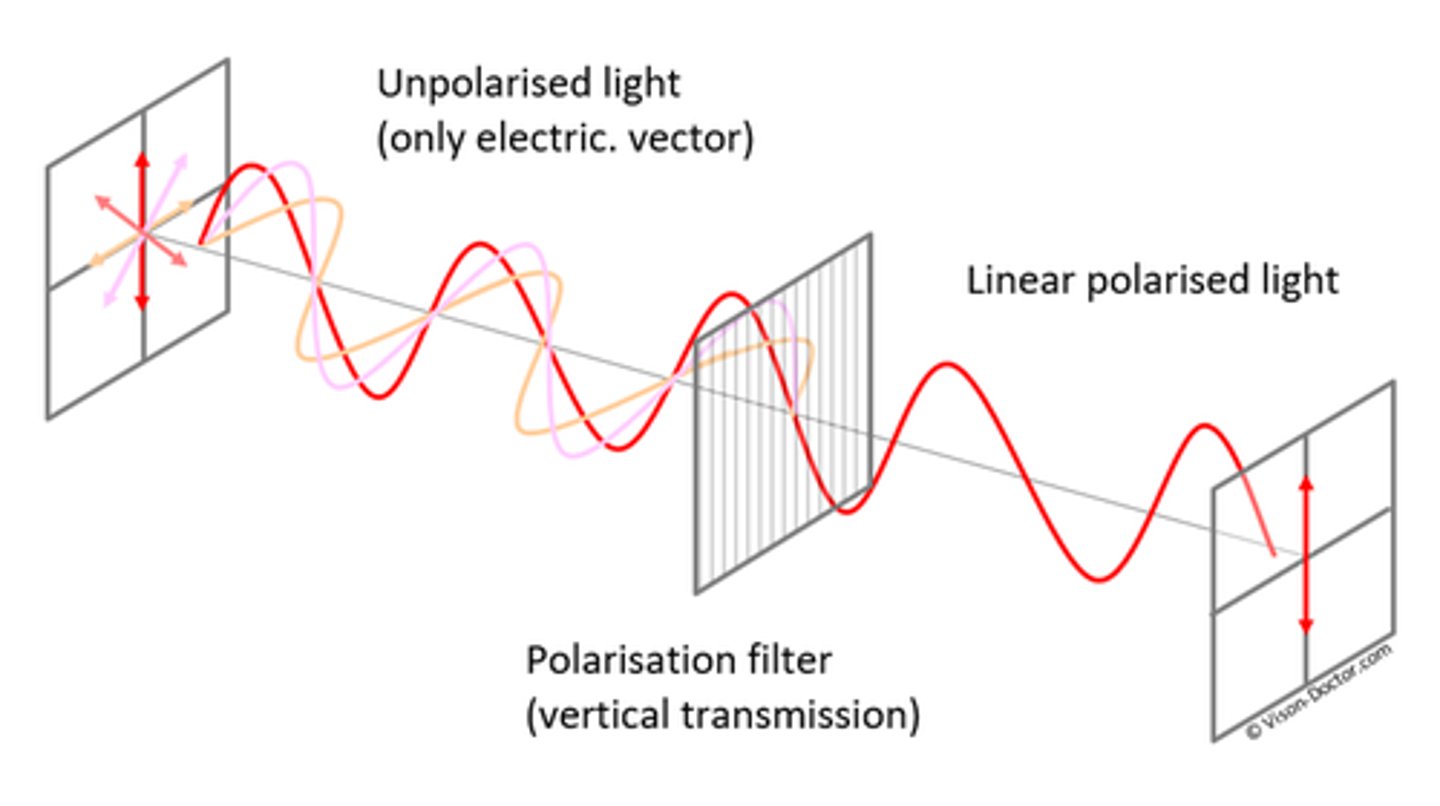
Why can longitudinal waves not be polarised? (1)
The direction of energy transfer is already in only one direction (parallel) and restricted in one plane so they cannot be polarised as they already are.
What is meant by the intensity of a progressive wave? (1)
This is defined as the radiant power passing at right angles through a surface per unit area.
What is the equation for the intensity of a progressive wave? (1)
The equation for intensity (I) is I = P / A where P is the radiant power (W) of the wave and A is the surface area (m²) of the source of the progressive wave (this is usually a sphere).
What is the S.I. unit for the intensity of a progressive wave? (1)
The unit of intensity is watts per meter squared (Wm⁻²)
How is the intensity of a progressive wave related to the amplitude? (1)
The intensity is directly proportional to the amplitude squared. I ∝ A²
What is an electromagnetic wave? (1)
This is a transverse progressive wave consisting of magnetic and electric fields which oscillate at right angles to each other.
What are some properties of electromagnetic waves? (3)
- They can travel through a vacuum.
- They have a speed of 3 x 10⁸ms⁻¹ in a vacuum.
- They are transverse waves and can be polarised.
What is the spectrum of electromagnetic waves? (1)
These are the different ranges of wavelengths that electromagnetic waves can have, they are: Radio waves, Microwaves, Infrared, Visible light, Ultraviolet, X-ray and Gamma ray
What are typical wavelengths of each part of the spectrum of electromagnetic waves?

How can the polarisation of visible light be shown? (2)
- Place two polarising filters on top of each other.
- Rotate one filter by 90 degrees and the light intensity will decrease to a minimum as light cannot pass through the filter that is polarised in the perpendicular direction.
How can the polarisation of microwaves be shown? (3)
- Place a microwave transmitter and receiver on opposite sides of a rotatable metal grille.
- In vertical orientation, the microwaves can pass through it and maximum signal is detected.
- When the metal grille is rotated to horizontal orientation the signal will be reduced to a minimum as the polarised microwave light cannot pass through the grille as electrons are absorbing the microwave light.
What is the refractive index (n)? (1)
This is the ratio between the speed of light in a vacuum and the speed of light in a medium. It is unique for each medium and has no units.
What is the formula for the refractive index (n)? (1)
The formula is: n = c / v where c is the speed of light (3 x 10⁸ms⁻¹) and v is the speed of light in the medium (ms⁻¹)
How can the angle of refraction be calculated? (2)
- If the light leaves a medium with refractive index n_1 and has an angle of incidence of θ_1 to a medium of n_2 at an angle of incidence θ_2 the following equation links these variables. (The angles are measured relative to the normal of the two media.)
- n_1 sin θ_1 = n_2 sin θ_2
What is meant by total internal reflection of light? (2)
This is when all the light incident on a boundary is reflected back into the original medium. This happens due to two conditions being met:
- The light is travelling from a medium with a higher refractive index to a medium with a lower refractive index.
- The angle of incidence of the ray to the normal must be greater than the critical angle of the medium.
What is the critical angle? (1)
This is the angle of incidence at which the angle of refraction will be equal to 90 degrees.
What is the equation for the critical angle when the light is trying to pass into air? (1)
If the light is travelling from a material with the refractive index (n) the critical angle is given by: sin C = 1 /n
What is the principle of superposition of waves and what does it look like? (1)
The principle of superposition states when two waves meet at a point, the resultant displacement of the wave at that point is equal to the sum of the displacements of the individual waves.
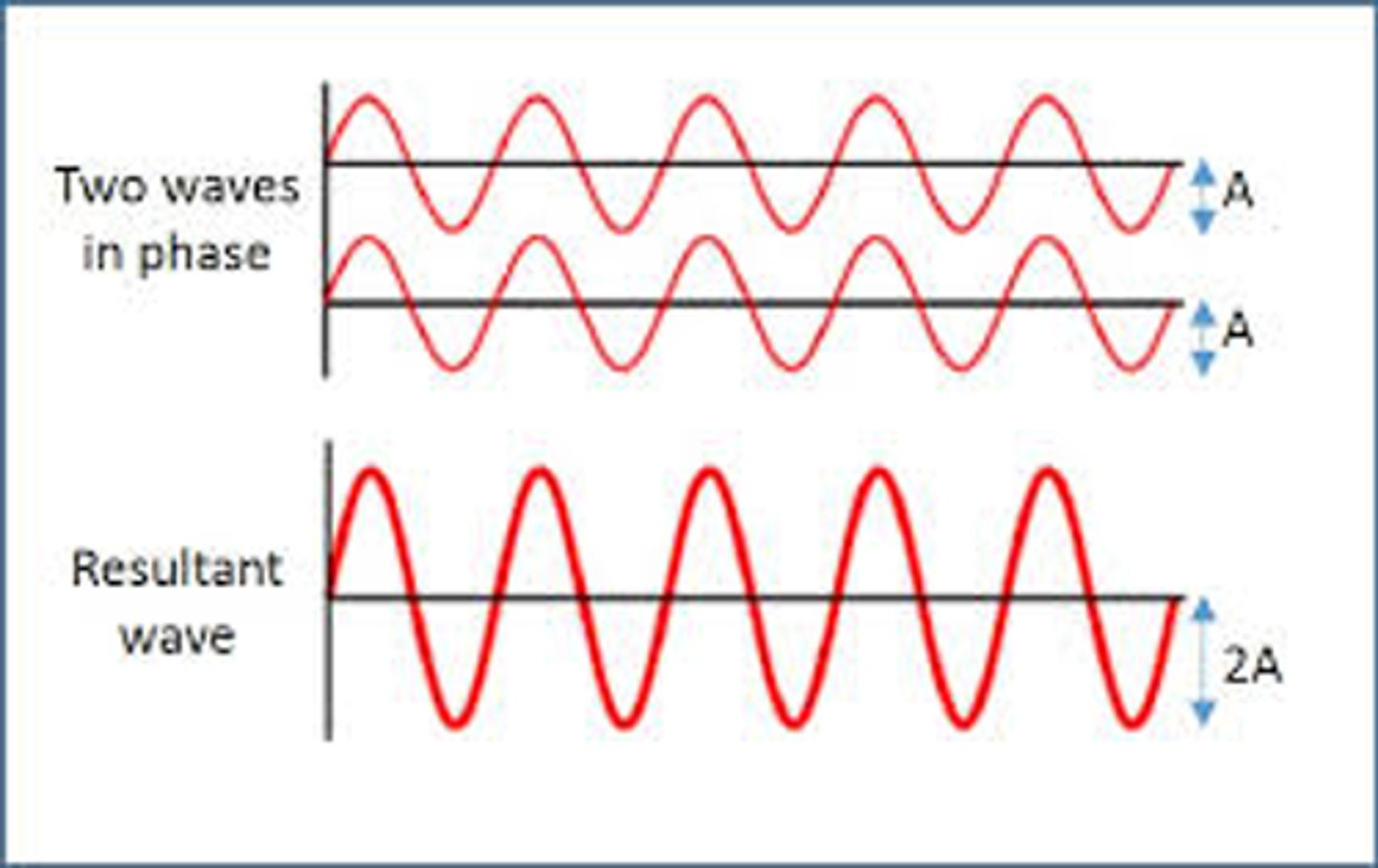
What is meant by interference? (1)
This is when two coherent waves superpose with each other when they are in the same position. There is constructive and destructive interference.
What is meant by coherence? (1)
Two waves are coherent when they are emitted with a constant and unchanging phase difference.
What is meant by path difference? (1)
This is the difference in the distance travelled by two waves to get from their respective sources to a specific point. It is usually measured in wavelengths.
What is meant by constructive interference and what does this look like? (1)
This occurs when the waves are in phase and have a path difference of mλ where m is an integer. There is a maximum resultant displacement.
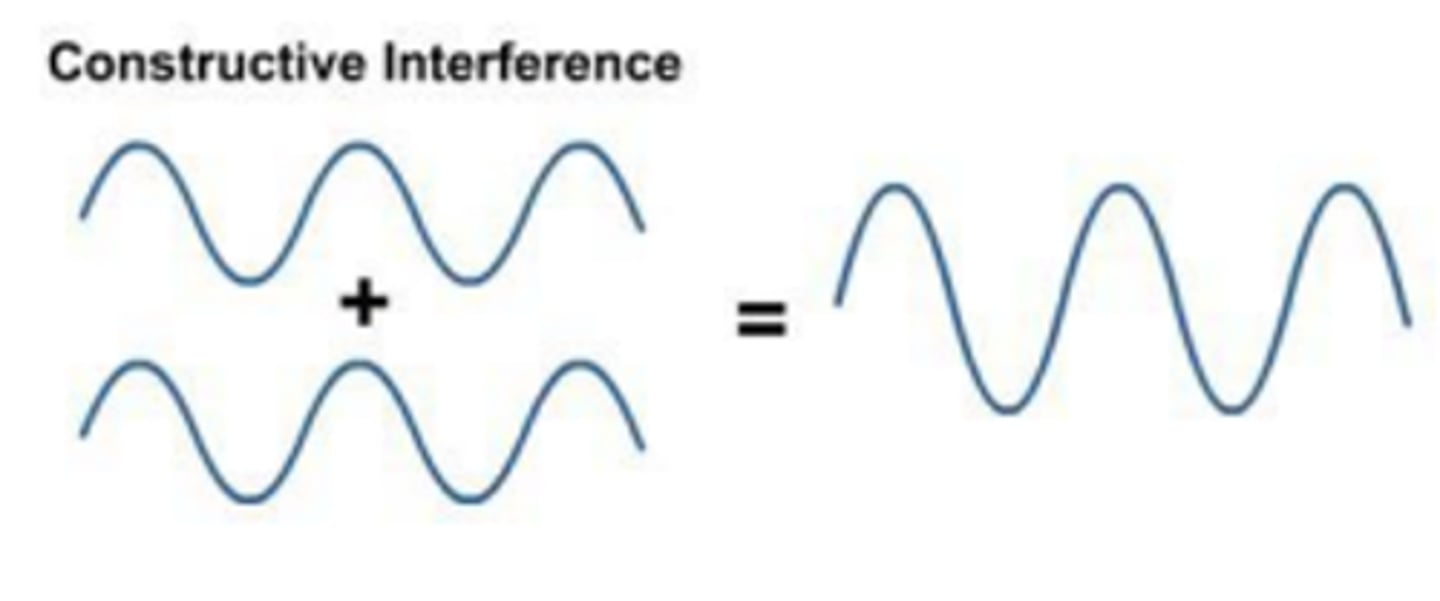
What is meant by destructive interference and what does this look like? (1)
This occurs when the waves are in antiphase and have a path difference of (m + 1 / 2) λ where m is an integer. There is a minimum resultant displacement.
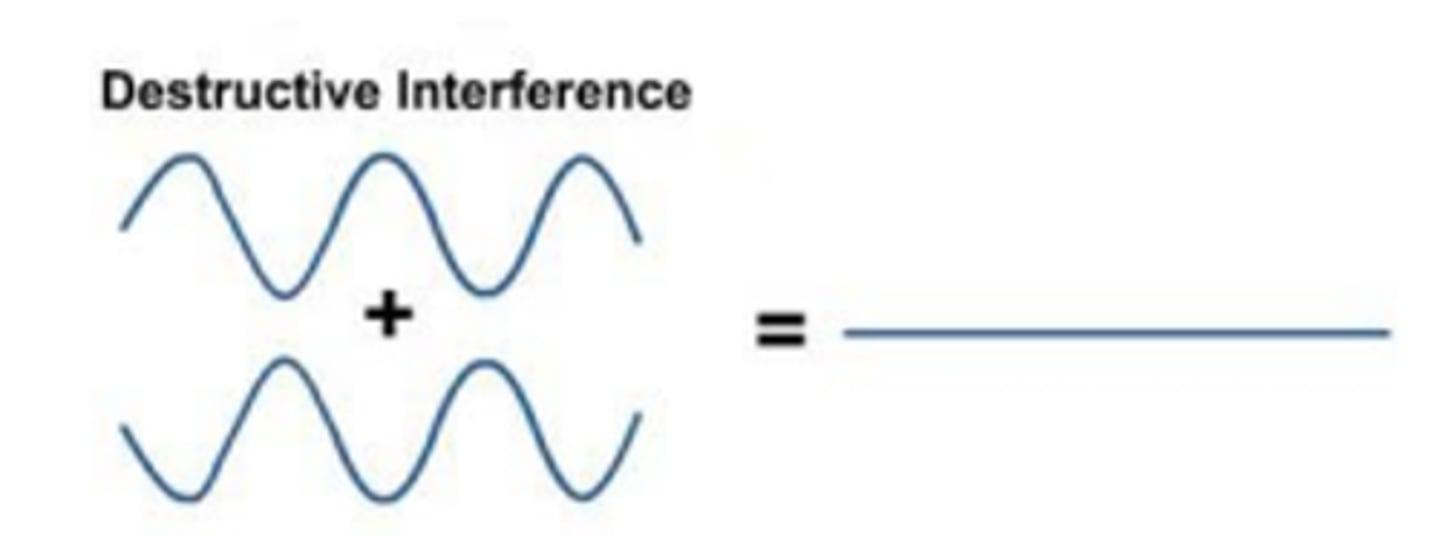
What is meant by two-source interference? (1)
This is when two sources emit waves and the waves interfere with each other creating an interference pattern with areas of constructive and destructive interference. This can be done with sound waves and microwaves.
How is Young's double slit experiment carried out? (2)
- A laser produces light of one wavelength and the laser is placed a distance (a) away from a sheet with 2 slits.
- The two coherent waves produced by the slits overlap and superpose, creating alternating bright (maxima) and dark (minima) fringes on a screen.
What does Young's double slit experiment look like? (1)
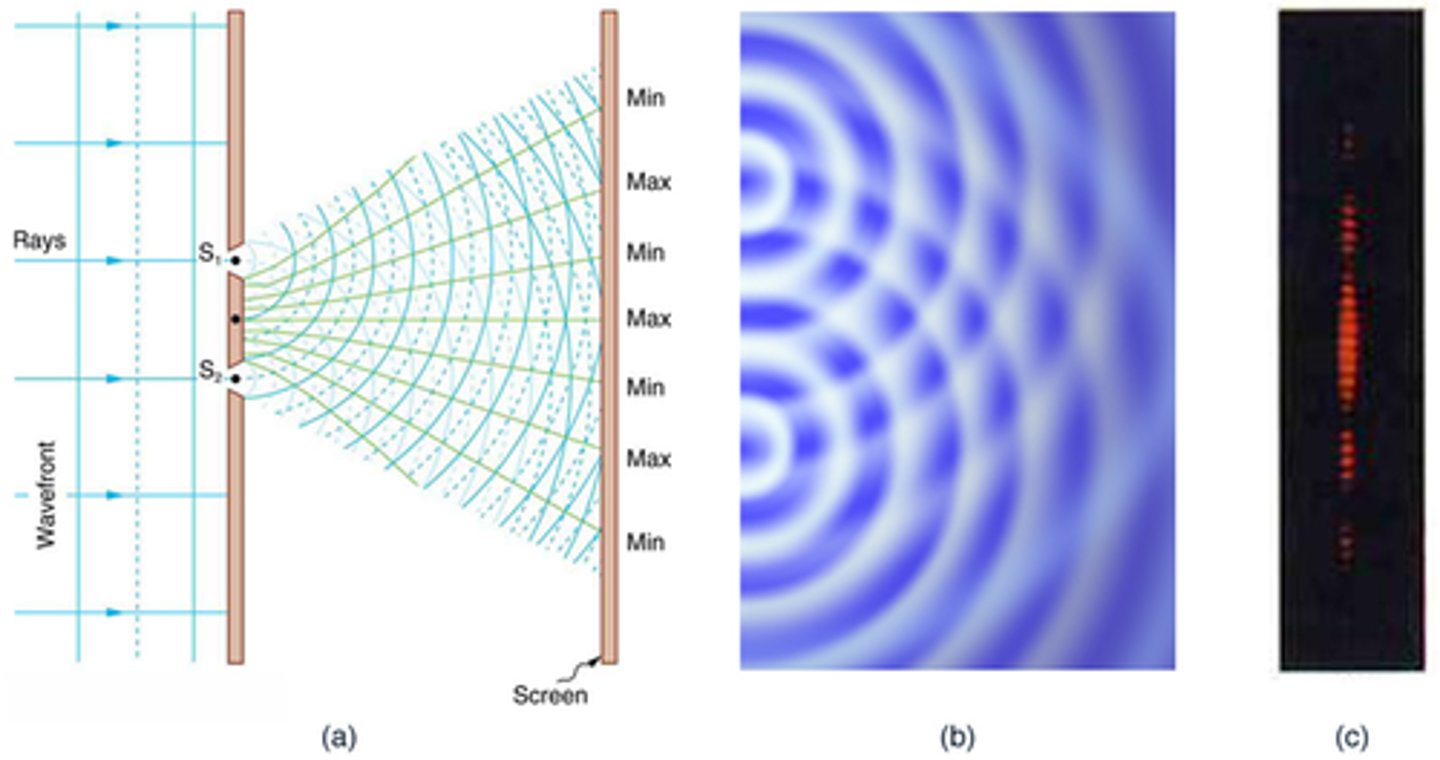
What is the equation used for Young's double slit experiment? (3)
- If a is the distance between the laser and the slits, x is the distance between two adjacent maxima points and D is the distance between the slits and the screen.
- The equation λ = ax / D can be used to find the wavelength of the light.
- This is only valid if D is much larger than a.
What is a diffraction grating? (2)
This is a material with many lines on it, the light can pass through the lines which act as slits. This gives an interference pattern of dark and bright fringes on a screen.
What equation is used to calculate the wavelength from a diffraction grating (2)
- If we have a grating with the order of maxima (n), the angle θ between the 0th and nth maxima and the distance between each slit (d) the wavelength can be found using the equation:
- d sin θ = n λ
What does Young's double slit experiment and the diffraction grating show about the nature of light? (1)
These experiments show that light has a wave like nature.
What are stationary waves? (1)
These are waves that oscillate in time but their profile does not move. They store energy and do not transfer it. It has a series of alternating nodes and antinodes.
How are stationary waves formed? (1)
They are formed when two progressive waves with the same frequency and amplitude that travel in opposite directions superpose.
How can a stationary wave be formed using a stretched string? (4)
- Pull the string over a pulley and attach the other end to a vibration generator.
- Use the vibration generator to oscillate the string until a set frequency where a stationary wave is formed.
- The initial wave produced is reflected at the pulley and, producing two waves with the same frequency, travelling in opposite directions, which superpose to make a stationary wave.
- This looks like:
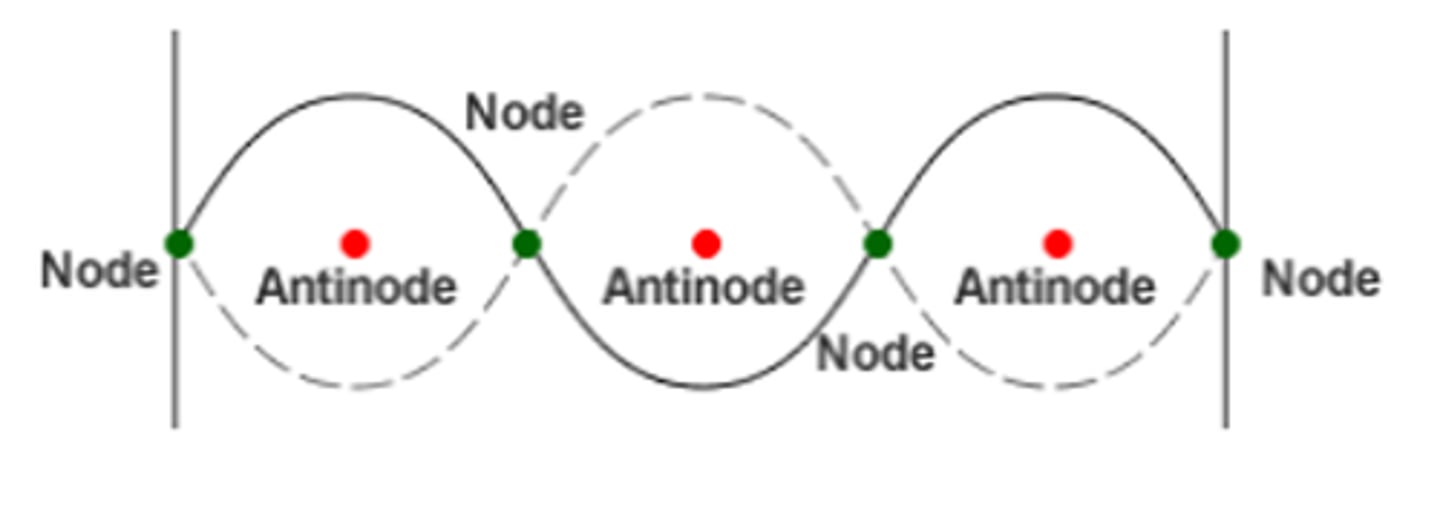
How can a stationary wave be formed using microwaves? (3)
- A microwave transmitter emits a microwave.
- This is then reflected off a plate and superposes with the original wave to form a stationary wave.
- List
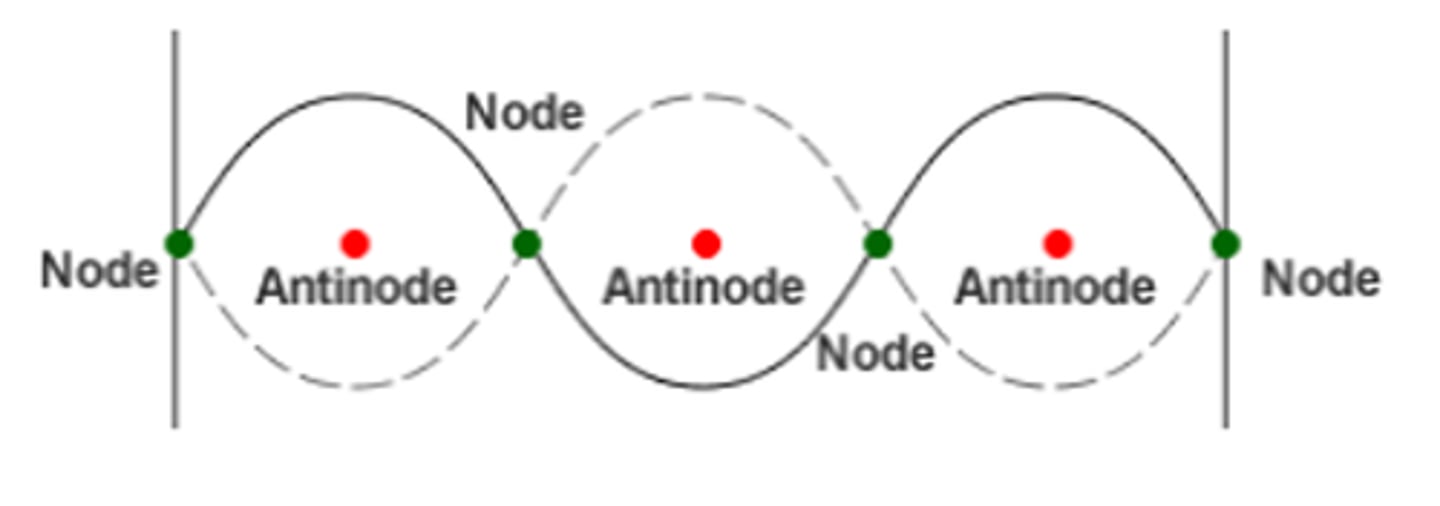
How can a stationary wave be formed using sound in an air filled tube? (3)
- Use a tuning fork to produce a loud sound and hold it over a tube.
- Adjust the length of the tube until a stationary wave is produced.
- The shape will depend if the tube is closed or open.
What does a stationary wave look like for a stretched string? (1)
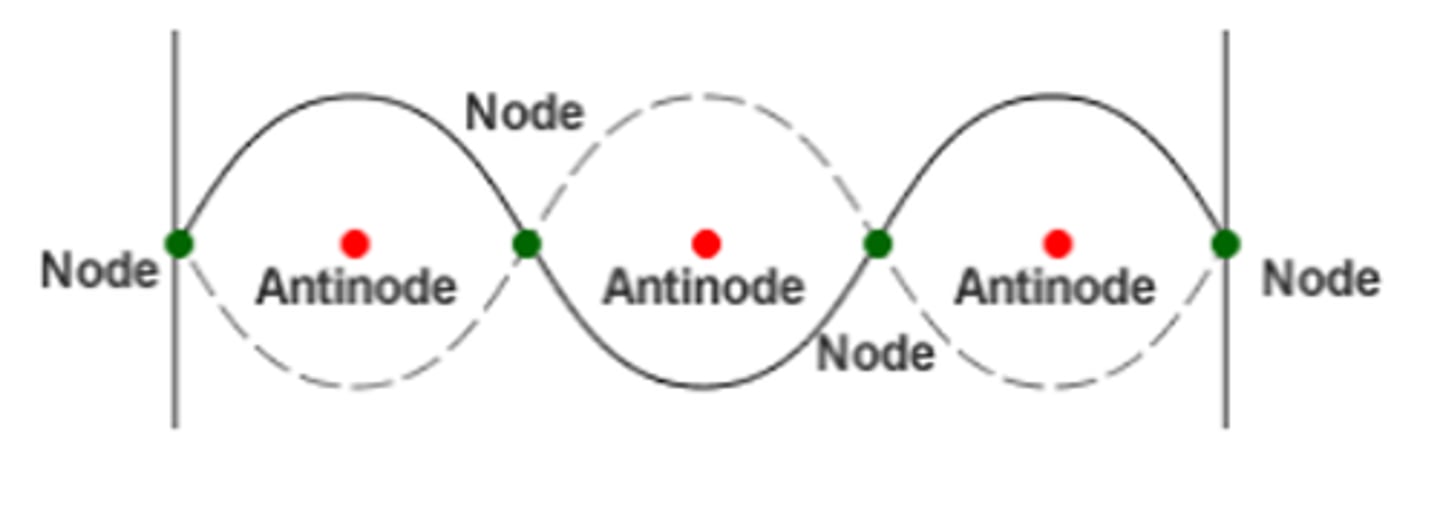
What is the similarity between a stationary wave and a progressive wave? (1)
They both cause oscillations in particles.
What is the difference between a stationary wave and a progressive wave? (1)
A progressive wave transfers energy from one place to another whilst a stationary wave stores energy in one place.
What is a node on a stationary wave? (1)
This is a point on a stationary wave which has zero amplitude.
What is an antinode on a stationary wave? (1)
This is a point on a stationary wave which has maximum displacement
What does a stationary wave in an air filled tube look like? (2)
- If the column is open at both ends, there will be antinodes at each end and there will be a series of nodes and antinodes in the middle.
- If the column is open at one end only, the open end will have an antinode and the closed end will have a node and there will be a series of nodes and antinodes in the middle.
What is the distance between two adjacent nodes (or antinodes)? (1)
This is equal to λ / 2 where λ is the wavelength of the progressive wave.
What is the fundamental mode of vibration? (1)
The fundamental mode of vibration of a stationary wave is the lowest frequency at which vibration is possible. This is called the first harmonic.
What are harmonics? (2)
- These are specific frequencies where a different pattern of stationary wave will be formed specific to each type of material and wave.
- Each harmonic has a frequency which is an integer multiple of the frequency for the fundamental mode of vibration.
What are the wavelength and frequencies of different harmonics? (1)
